Friday 27 February 1942
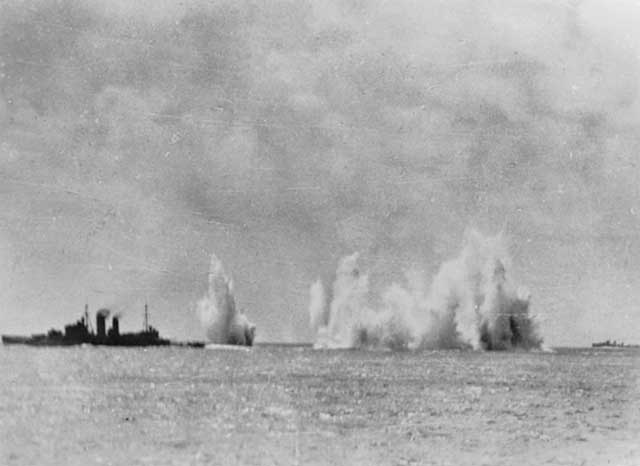 |
| HMS Exeter (right, barely visible under the spray) and Australian cruiser HMAS Hobart (D63) under aerial attack by Japanese aircraft in the Battle of Java Sea. The date of this picture has not been positively established may be from 27 February 1942. Or, it may be from an earlier incident on 14-15 February 1942. |
Battle of the Pacific: Admiral Karel Doorman has his fleet at sea east of Surabaya in search of a reported Japanese invasion fleet heading for Java on
27 February 1942. After spending all night and all morning in a fruitless search, his ships spot the Japanese ships at about 16:00. within about fifteen minutes, the two fleets are firing guns and torpedoes at each other. Allied cruiser HMS Exeter is hit in the boiler room by a Japanese shell and heads back to Surabaya, and destroyer HNMLS Kortenaer sinks quickly after being hit by a torpedo. A gun battle between Royal Navy destroyer Electra and Japanese light cruiser Jintsū and destroyer Asagumo leads to the loss of Electra (Asagumo is damaged and withdraws). At 18:00, having lost two ships with a third badly damaged, Doorman breaks off the battle and heads west in an attempt to intercept the invasion transport ships. However, on the way, Royal Navy destroyer Jupiter hits a mine and sinks, compounding the damage. The Japanese pursue Doorman and there is another furious gun-and-torpedo battle which leads to the sinking of Dutch cruisers De Ruyter and Java. Doorman goes down with his ship, and only 111 men survive from both ships. Following orders, the only two surviving Allied ships, cruisers Perth and Houston, retreat back to Tanjung Priok.
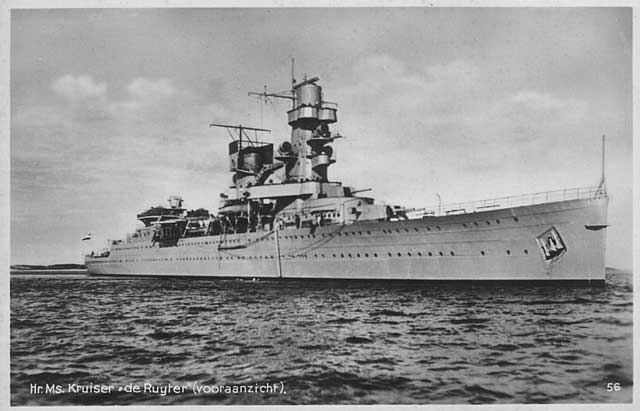 |
| Dutch flagship De Ruyter, sunk on 27 February 1942. |
The Battle of the Java Sea is decisive for the fate of the Netherlands East Indies. While the battle delays the Japanese invasion by the day, that comes at a cost to the Allies of virtually their entire fleet in the Netherlands East Indies (Japanese losses are not known with precision but apparently are very light). The fate of Java is now sealed and the Allies have almost no naval forces left in the region aside from the battered Exeter and a few destroyers. This arguably is the height of Japanese naval power in the Pacific, though a lot of fighting remains.
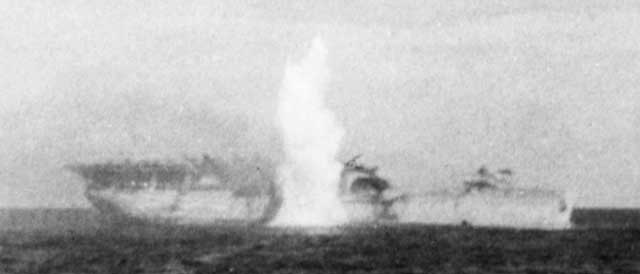 |
| In this perfectly timed photo, the U.S. Navy seaplane tender USS Langley (AV-3) is torpedoed by USS Whipple (DD-217), after being abandoned, south of Java, 27 February 1942. Naval History and Heritage Command NH 92476 USS LANGLEY (AV-3) |
Allied woes at sea on 27 February 1942 do not end there, however. US Navy aircraft carrier USS Langley, the country's first aircraft carrier and now serving as a seaplane tender, is attacked early in the day south of Tjilatjap (Cilacap), West Java, along with US destroyers Whipple and Edsall by sixteen Mitsubishi G4M "Betty" bombers. They are flying out of Denpasar airfield on Bali and are escorted by 15 A6M Reisen "Zero" fighters. While Langley (which is carrying 32 P-40s) evades two bombing runs, it takes five 60- and 250-kg bombs on the third pass and bursts into flames. At 13:32, the crew abandons ship, and the escorting destroyers put two torpedoes into Langley to make sure that the Japanese don't salvage it. The tragedy of the Langley does not end there, either, as many of her surviving crew are on another ship, USS Pecos, when it is sunk while en route to Australia.
 |
| Polish soldiers in London, 27 February 1942 (Imperial War Museum). |
Eastern Front: In the Crimea, Soviet Lieutenant General Dmitry Timofeyevich Kozlov launches an offensive along a section of the front at the Parpach Narrows at 06:30. The Red Army has 93,804 troops, 1,195 guns and mortars, 125 anti-tank guns, 194 tanks, and 200 aircraft. The offensive begins with a 230-gun artillery barrage, but the shelling is poorly aimed and does little to disrupt the German defenses. The Germans have their 46th and 132nd Infantry Divisions on the 42 Corps front along with the Romanian 18th Infantry Division. The Germans also have Gruppe Hitzfeld in reserve.
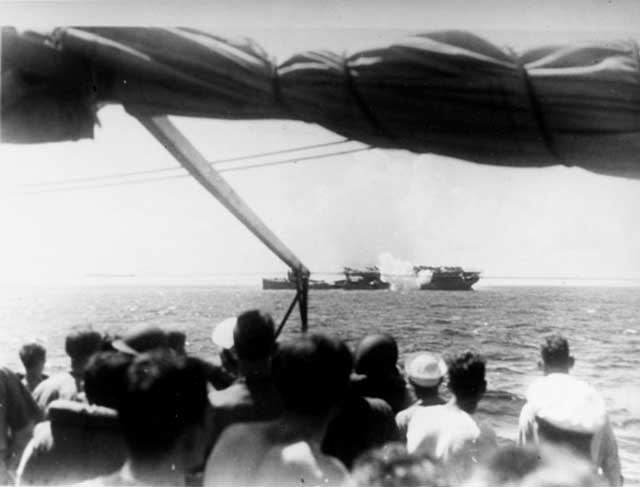 |
| The crew of destroyer USS Whipple (DD-217) watches as its torpedo (fired to prevent the ship from falling into enemy hands) strikes USS Langley south of Java (Naval History and Heritage Command NH 92475 USS LANGLEY (AV-3)). |
The Germans rely on a hedgehog defense of fortified strongpoints at the villages of Tulumchak, Korpech’, and Koi-Asan. They have built strong fortifications all along the front, and they are aided by warm weather which creates muddy conditions benefiting the defense. The Soviets must advance across a flat, 80-square kilometer plain which exposes them to brutal counter-fire. Soviet tanks, particularly the heavy KV-1s which are slow and make good targets, sink in the mud. Still, the Red Army soldiers take Tulumchak, which is held by the Romanian 18th Infantry Regiment. However, the Germans hold their other two strongpoints at Korpech’ and Koi-Asan after brutal fighting. The Luftwaffe makes 40 Stuka sorties which help to knock out 93 Soviet tanks in total, including 28 KV-1s. The Soviets do make minor gains but at a brutal cost.
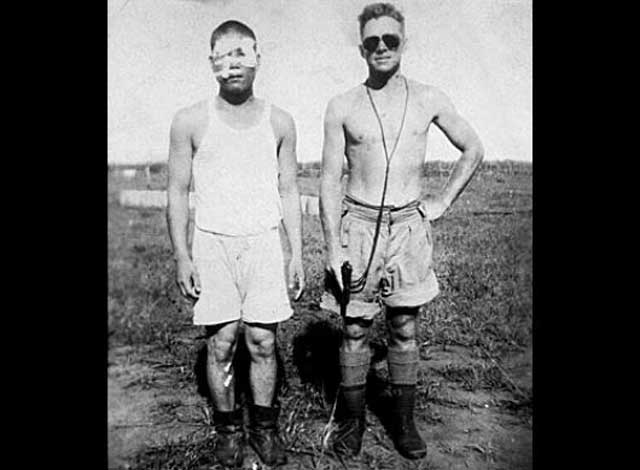 |
| Sergeant Hajime Toyoshima (left), Australia’s first Japanese prisoner of war, Bathurst Island, 27 February 1942. Toyoshima piloted of a Zero fighter damaged during the 19 February air raid on Darwin. After being forced to crash-land on Melville Island, Toyoshima was disarmed and captured by Aborigines who took him to Bathurst Island to hand over to Sergeant Leslie Powell (right), 23rd Field Company, Royal Australian Engineers. Powell, who had been sent to maintain demolition installations on the island and was unarmed, used Toyoshima’s service pistol to escort him into captivity. |
European Air Operations: RAF Bomber Command sends 68 bombers (33 Wellingtons, 17 Manchesters, and 18 Hampdens) to bomb the Kiel drydock again where Gneisenau is being repaired. However, the weather is cloudy and only 50 bombers even drop their bombs - but where they drop is a mystery because there is no report of damage in Kiel. In another mission, 33 bombers (three Whitleys are lost) attack Wilhelmshaven and heavy cruiser Scharnhorst, but again the weather is poor and only 26 bombers drop their bombs - somewhere - to no effect. Another 15 bombers (11 Hampdens and 4 Manchesters) lay mines off the Frisian Islands.
The Luftwaffe bombs and sinks 269-ton British coaster Fernside off Banff, Aberdeenshire, Scotland.
 |
| Tanker R.P. Resor, sunk on 27 February 1942. |
Battle of the Atlantic: U-578 (KrvKpt. Ernst-August Rehwinkel), on its third patrol out of St. Nazaire, torpedoes and sinks 7451-ton tanker R.P. Resor about 20 miles east of Manasquan Inlet, New Jersey. The torpedo hits at 06:36 and ignites oil which sprays into all along the ship. The flames make abandoning ship almost impossible, and the sole lifeboat that can be launched is burned up. There are only two survivors of the 50 men on board. The ship stays afloat at an extreme angle, but the stern grounds in 122 feet of water when it is taken under tow and the ship sinks on 1 March.
U-432 (Kptlt. Heinz-Otto Schultze), on its fourth patrol out of La Pallice, torpedoes and sinks independent 8215-ton US tanker Marore about 3.5 miles off Wimble Shoals near Cape Hatteras. Captain Schultze then surfaces and begins the shelling the ship. The crew of the Marore abandons ship just in time. All 39 men survive.
U-156 (Kptlt. Werner Hartenstein), on its second patrol out of Lorient, uses its damaged deck gun (which exploded during a surface attack on the island of Aruba) sinks 2498-ton British freighter Macgregor about 15 miles northeast of Cabo Frances Viejo, Dominican Republic. Hartenstein follows the freighter for 16 hours until moonrise allows him to make his attack. The U-boat's gun erupts from 1600 yards at 22:35 and the first shot kills or wounds the freighter's gun crew. The Macgregor is able to send a distress signal before the guns destroy the freighter's bridge. After 35 minutes, the freighter is ablaze and the crew abandons ship. Amazingly, only one man on the Macgregor perishes, hit by the opening shot from U-156. There are 30 survivors.
 |
| Italian freighter Tembien, sunk off Tripoli on 27 February 1942. |
Battle of the Mediterranean: Italian forces based on Rhodes launch a major counterattack against British commandos trying to take Kastelorizo in Operation Abstention. The weather is poor, making the landings difficult, but Ammiraglio di Divisione (Vice Admiral) Luigi Biancheri manages to land enough troops from gunboats Lupo, Lince, MAS 546, and MAS 561to isolate the poorly equipped British troops. During the afternoon, destroyers Crispi and Sella also land more troops to bring the total Italian Army presence to 258 soldiers and 80 marines. Now outnumbered, the commandos retreat to Nifti Point, harassed by naval gunfire by Lupo. Offshore, the Royal Navy makes a half-hearted attempt to intervene but can't locate the Italian ships. The British intend to land reinforcements on destroyer Rosaura, but the heavy Italian naval presence is calling that into doubt. Operation Abstention has become a muddled fiasco, but the British are determined to take the island and thus send more troops from Alexandria to land on the 28th.
Royal Navy Submarine HMS Upholder torpedoes and sinks 5584-ton Italian freighter Tembien about 24 miles (40 km) from the Tripoli lighthouse.
 |
| The Bruneval radar station. |
Special Operations: The British execute Operation Biting, an overnight raid on German coastal radar installations in northern France. After several days of poor weather, conditions are right for aircraft of RAF No. 51 Squadron based at RAF Thruxton to drop "C" Company of the 2nd Parachute Battalion at Bruneval, France. The Commandos take the cutting-edge Wurzburg radar installation by force, killing one German guard and taking two others as prisoners. Rather than destroying the equipment, the Commandos remove it and take key pieces to the nearby beach on special trolleys. However, the Commandos find the beach to be under enemy fire, so they return to the installation and, after a fierce firefight with German troops, re-occupy it while other troops clear the beach. Six Royal Navy landing craft then appear on schedule and the entire force (less six Commandos who get lost) board and return to England. The Commandos lose two killed and eight wounded, while the Germans lose 5 killed, two wounded, and five missing men. The raid is both a technical and propaganda success for the British and leads to the expansion of British airborne forces. British scientists use the equipment to develop radar countermeasures, including "Window" (chaff), that are highly effective in later air raids. The British will erect a memorial to the Biting raid at Bruneval.
 |
| Short S23 C-Class S.849, Empire Flying Boat, A18-12 G-AEUG "Coogee" VH-ABC (see above photo) of 33 Squadron RAAF crashes on landing in Cleveland Bay near Townsville on 27 February 1942. Six RAAF crew perish and are buried at Townsville War Cemetery. |
US/Mexican Relations: President Roosevelt signs an executive order establishing a Joint Mexican-U.S. Defense Commission.
British/Venezuelan Relations: Great Britain cedes Patos Island to Venezuela. This is one of Britain's oldest possessions in the New World, dating to 1628 and being part of the colony of Trinidad and Tobago. In exchange, the Venezuela government gives Trinidad and Tobago Soldado Rock. The two islands are or will become national parks and are of no strategic importance.
 |
| HMS Duke of York at sea, 27 February 1942. © IWM (A 7556). |
US Military: US Navy ship Sea Witch deposits 27 crated P-40s at Tjilatjap, Java. With the Japanese about to invade, it is doubtful that they can be prepared in time to enter combat.
US Government: There is a tense Cabinet meeting at the White House about Japanese internment. At the meeting, representatives of the US Army claim that ethnic Japanese in the Hawaiian Islands will all have to be brought to the mainland for internment. President Roosevelt disagrees and wishes them to be interned on Molokai. The issue is left unresolved, but eventually, the Army's position will prevail.
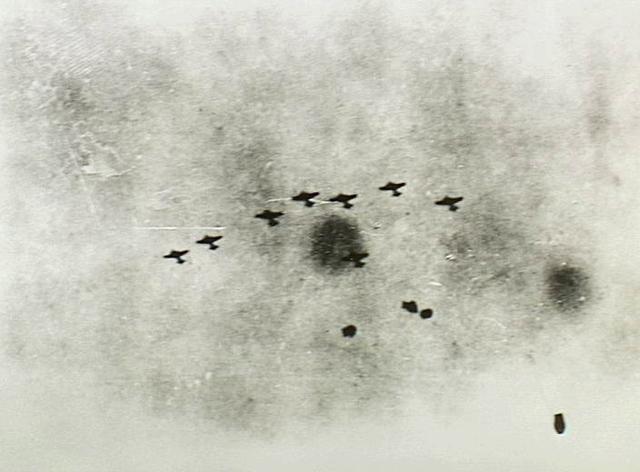 |
| A formation of Japanese bombers attacking warships during the Battle of the Java Sea, as seen from the Australian cruiser, HMAS Hobart, February 1942. Australian War Memorial P02620.005. |
British Homefront: British physicist and radio astronomer James Stanley Hey
discovers radio emissions coming from the Sun. This is a major development in the field of radio astronomy - the study of celestial objects at radio frequencies. Hey's discovery is related directly to the war, as he realizes today that complaints from the RAF of jamming of anti-aircraft radars are not the result of German actions, but are natural phenomenon from the Sun.
American Homefront: Scientist Edwin Hubble publishes an article, "The Problem of the Expanding Universe," in
Science magazine. Hubble writes that he has validated scientist Albert Einstein's General Theory of Relativity by proving that light takes longer than it should to arrive at earth from distant galaxies. The reason is that the universe is expanding. The theory of the expanding universe is one of the cornerstones of modern cosmology. The question of how fast the universe is expanding remains unresolved to this day.
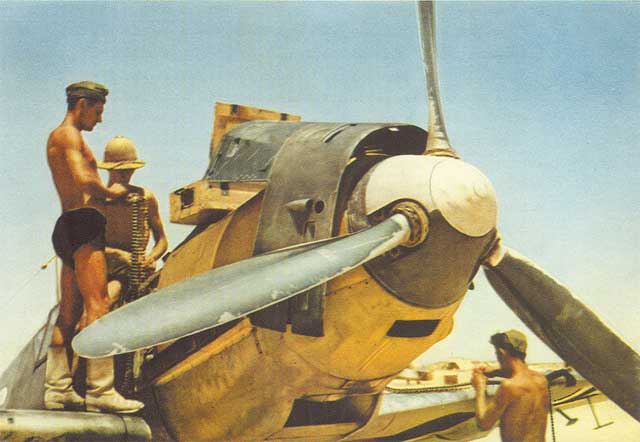 |
| Armorers reloading a Messerschmitt Bf 109E of Jagdgeschwader 27 (JG27), North Africa, February 1942. |
February 1942
February 1, 1942: The US Navy Strikes Back
February 2, 1942: Germans Recovering in Russia
February 3, 1942: Japanese Shell and Bomb Singapore
February 4, 1942: Battle of Makassar Strait
February 5, 1942: Empress of Asia Sunk
February 6, 1942: The Christmas Island Body
February 7, 1942: The Double-V Campaign
February 8, 1942: Japan Invades Singapore
February 9, 1942: French Liner Normandie Capsizes
February 10, 1942: US Car Production Ends
February 11, 1942: Tomforce Fails on Singapore
February 12, 1942: The Channel Dash
February 13, 1942: Japanese Paratroopers In Action
February 14, 1942: RAF Orders Terror Raids
February 15, 1942: Japan Takes Singapore
February 17, 1942: Indian Troops Defect to Japanese
February 18, 1942: Battle of Badung Strait
February 19, 1942: FDR Authorizes Internment Camps
February 20, 1942: O'Hare the Hero
February 21, 1942: Crisis in Burma
February 22, 1942: Bomber Harris Takes Over
February 23, 1942: Bombardment of Ellwood, California
February 24, 1942: US Raid on Wake Island
February 25, 1942: Battle of Los Angeles
February 26, 1942: Gneisenau Eliminated
February 27, 1942: Battle of Java Sea
February 28, 1942: Battle of Sunda Strait
2020













No comments:
Post a Comment